In the winter of 2001, David Biggs proposed to us a project related to the Maze area of our theme, The Seven Ages. The Hanged One was intended to be a contemplative meditation garden where one could ponder the issues related to the Justice, the stage of life which invites reflection on one’s past and decisions about one’s future. After the event, David sent us this final report, which we feel is a good anatomy of a Burning Man grant project. It illuminates the challenges and rewards of creating an installation for Burning Man, and shows how a project can engage participants at our event, and also effect groups of people beyond our immediate community.
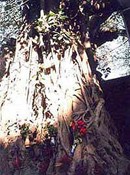 David writes:
David writes:
The inspiration for this piece came about with my experience in previous years and from objects encountered during my stay in Vietnam. I decided to create a small environment within which participants could both appreciate the surrounding desert environment and meditate upon their own questions in a quiet, peaceful space. I allied this piece with the theme art connected to the Maze as the stage of life in the Seven Stages known as “Reflection.” I found the tarot image of The Hanged One to be particularly useful as a thematic reference because of the card’s implication towards surrender towards higher wisdom and the Greater Being as well as the visual reference of a person hanging upside down from a tree in meditation.
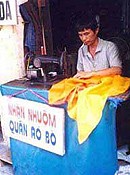 I modeled the tree after “cay da” or Banyan Tree from Viet Nam. This tree grows for several hundred years and offers shade and a common meeting place for people in a village. They are also planted outside temples and shrines because the spirit of this tree is believed to be a good, protective one. Particularly old trees are even honored with flowers and incense, and people living near the tree burn incense and pray to it for good luck and blessings.
I modeled the tree after “cay da” or Banyan Tree from Viet Nam. This tree grows for several hundred years and offers shade and a common meeting place for people in a village. They are also planted outside temples and shrines because the spirit of this tree is believed to be a good, protective one. Particularly old trees are even honored with flowers and incense, and people living near the tree burn incense and pray to it for good luck and blessings.
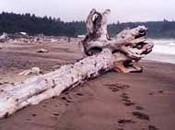 While living in Hanoi this past spring I also contracted the sewing of the lantern skins with a local upholsterer in the city’s old quarter. These 36 old streets once were the location for the 36 major trade guilds of the city from roughly 1200-1800. Today residents still come here though the guilds have changed. The particular street where my friend, Mr. Thanh, worked specialized in upholstery and repair of motorcycle seats. Mr. Thanh was particularly helpful in suggesting improvements to the lantern design and transport. I traveled to an outlying village to collect the rattan and bamboo used in the construction of the lanterns. Thanh and his friend helped me cut the lantern pieces to correct length and dimension. I’m also working to find Thanh’s daughter an appropriate hearing aid as she is deaf. In the course of drinking beer after the final work was completed, he told me how he is trying to find appropriate hearing aids so that his daughter may be able to go to school.
While living in Hanoi this past spring I also contracted the sewing of the lantern skins with a local upholsterer in the city’s old quarter. These 36 old streets once were the location for the 36 major trade guilds of the city from roughly 1200-1800. Today residents still come here though the guilds have changed. The particular street where my friend, Mr. Thanh, worked specialized in upholstery and repair of motorcycle seats. Mr. Thanh was particularly helpful in suggesting improvements to the lantern design and transport. I traveled to an outlying village to collect the rattan and bamboo used in the construction of the lanterns. Thanh and his friend helped me cut the lantern pieces to correct length and dimension. I’m also working to find Thanh’s daughter an appropriate hearing aid as she is deaf. In the course of drinking beer after the final work was completed, he told me how he is trying to find appropriate hearing aids so that his daughter may be able to go to school.
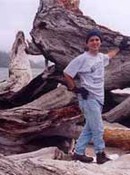 Upon returning to Seattle with the lantern load in June, I began looking for a Seattle-based source for the tree section. After one scouting trip and several hours of phone calls to organizations on the Olympic Peninsula, I found the Quileute Nation to be particularly receptive to my request. In exchange for a lantern and a promise to send them some pictures of the finished project, they allowed me to collect a vanload of logs to complete the piece. It was at this point that I saw coming together a unique aspect of the project, the trifold sources for materials from my three homes-Hanoi (lanterns), Olympic Coast (wood), Black Rock Desert (rocks).
Upon returning to Seattle with the lantern load in June, I began looking for a Seattle-based source for the tree section. After one scouting trip and several hours of phone calls to organizations on the Olympic Peninsula, I found the Quileute Nation to be particularly receptive to my request. In exchange for a lantern and a promise to send them some pictures of the finished project, they allowed me to collect a vanload of logs to complete the piece. It was at this point that I saw coming together a unique aspect of the project, the trifold sources for materials from my three homes-Hanoi (lanterns), Olympic Coast (wood), Black Rock Desert (rocks).
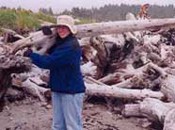 LadyBee was particularly helpful in sending me media packs to give the Quileute Nation upon my second collecting trip to La Push. Upon meeting members of the tribal council, I learned that to the Quileute and all coastal Salish peoples the red cedar is a tree with similar sacred values attached to it as the banyan tree in Vietnam. The red cedar is used to construct canoes, and canoes are used for construction of homes as well as all manner of canoes including racing and burial canoes. The trees washed up at St James island where I collected included hulking carcasses of 400 yr old trees such as this.
LadyBee was particularly helpful in sending me media packs to give the Quileute Nation upon my second collecting trip to La Push. Upon meeting members of the tribal council, I learned that to the Quileute and all coastal Salish peoples the red cedar is a tree with similar sacred values attached to it as the banyan tree in Vietnam. The red cedar is used to construct canoes, and canoes are used for construction of homes as well as all manner of canoes including racing and burial canoes. The trees washed up at St James island where I collected included hulking carcasses of 400 yr old trees such as this.
My sister was unable to attend the event this year but did fly down from Alaska to help my partner and I collect the wood. All in all, we collected about thirty logs such as this one weighing about 1.5 tons.

